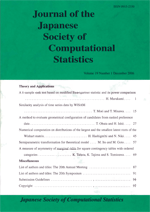Volume 25, Issue 1
Displaying 1-6 of 6 articles from this issue
- |<
- <
- 1
- >
- >|
Theory and Applications
-
2012Volume 25Issue 1 Pages 1-12
Published: December 20, 2012
Released on J-STAGE: February 04, 2015
Download PDF (307K) -
2012Volume 25Issue 1 Pages 13-24
Published: December 20, 2012
Released on J-STAGE: February 04, 2015
Download PDF (557K) -
2012Volume 25Issue 1 Pages 25-38
Published: December 20, 2012
Released on J-STAGE: February 04, 2015
Download PDF (302K) -
2012Volume 25Issue 1 Pages 39-49
Published: December 20, 2012
Released on J-STAGE: February 04, 2015
Download PDF (153K) -
2012Volume 25Issue 1 Pages 51-65
Published: December 20, 2012
Released on J-STAGE: February 04, 2015
Download PDF (201K)
Miscellaneous
-
2012Volume 25Issue 1 Pages 67-69
Published: December 20, 2012
Released on J-STAGE: February 04, 2015
Download PDF (50K)
- |<
- <
- 1
- >
- >|
